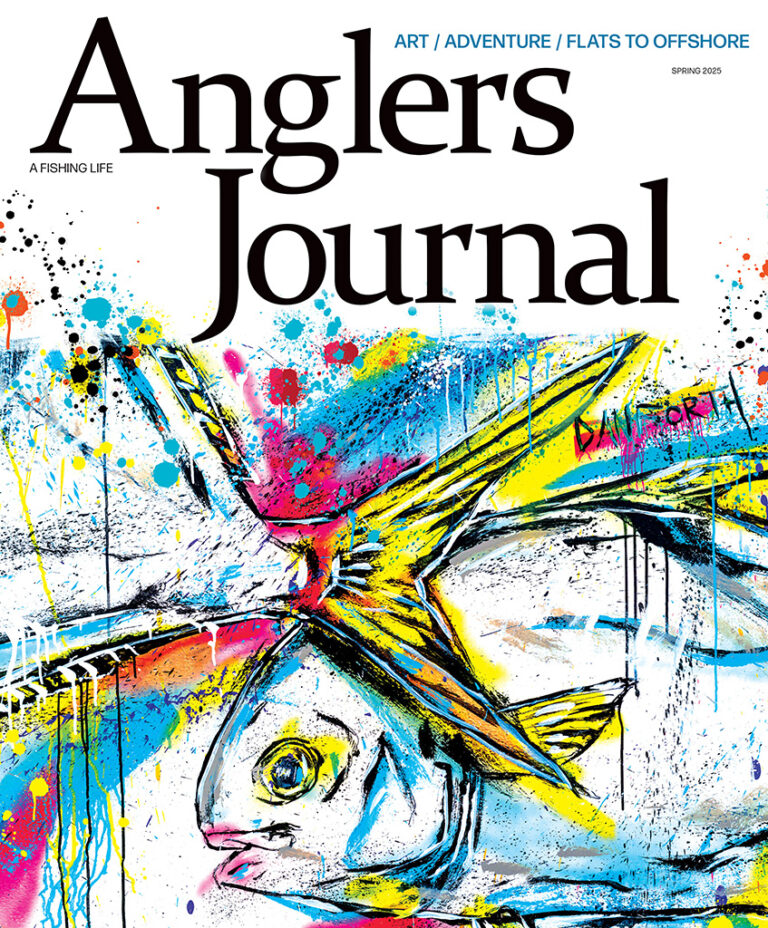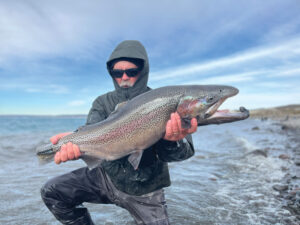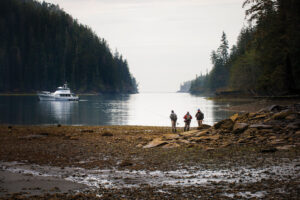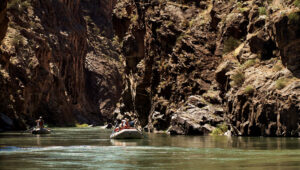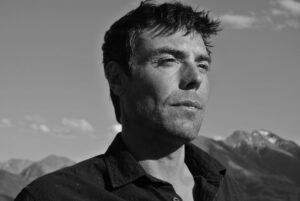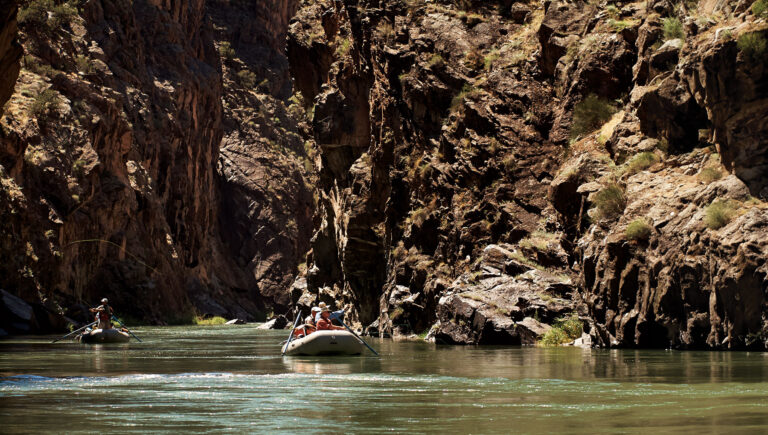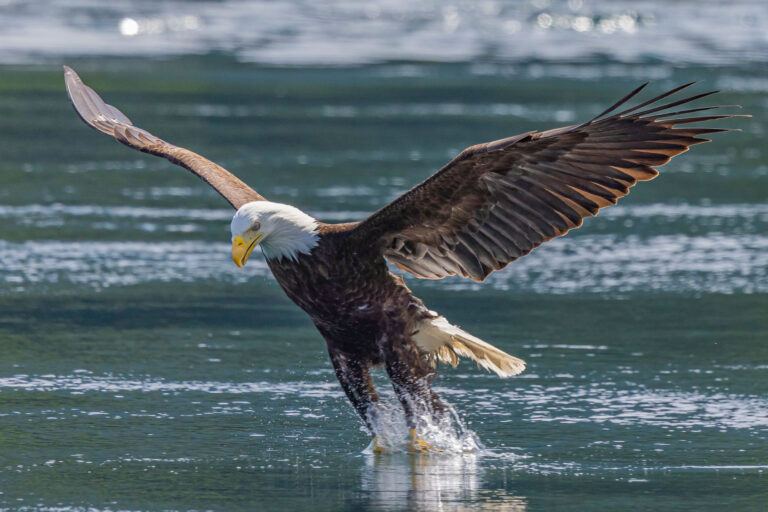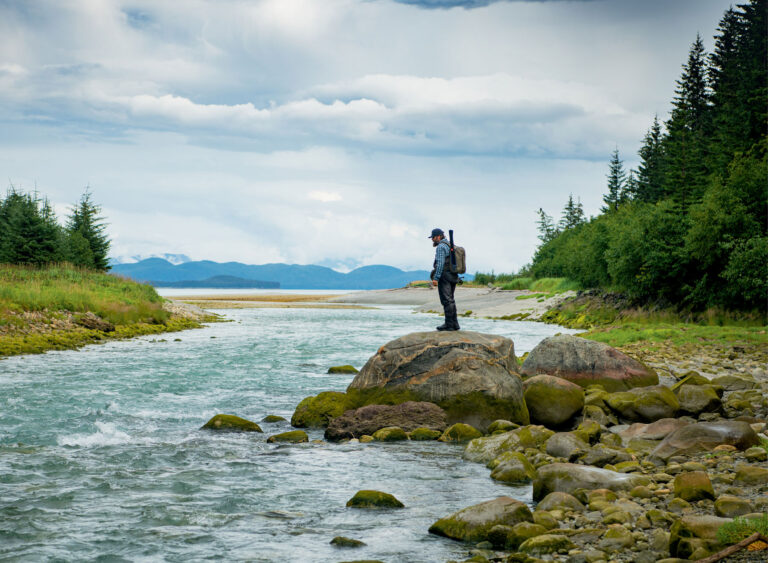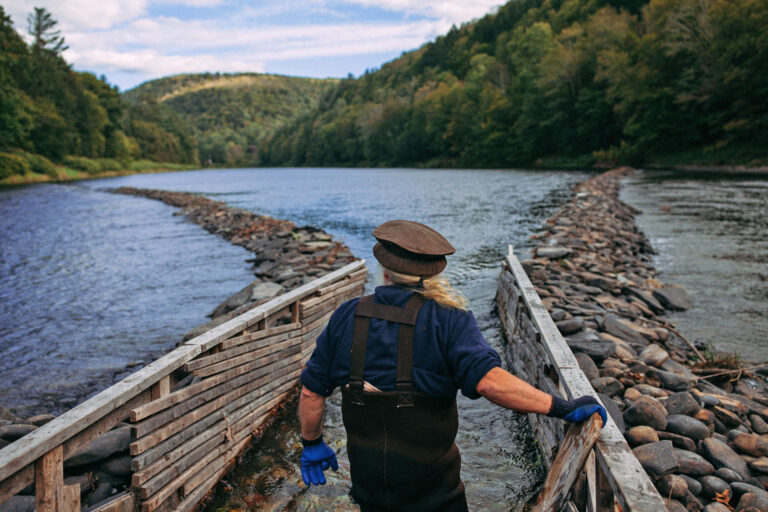At the risk of offending the people I fish and break bread with, I’m just going to say it: I don’t get Michigan in the winter. There’s the gray sky that begins in October and lasts until May, and all of that flat landscape covered with too much snow to walk around in, but too little to actually have any fun with. And yet, I know fishermen who swear they would never leave the state.
I’m visiting from the West, and each morning when I look out and see the same frost-heaved ground, I mutter that I can’t believe anyone actually chooses to live here — let alone fish here this time of year. And then I make a call to Josh Greenberg, owner of Gates Au Sable Lodge, for temporary relief from my cabin fever.
I book my first trip of the year down the Mason Tract section of the South Branch of the Au Sable River with guide Matt Verlac. It’s his first full-day trip of the year, as well, and although mid-February is not prime fishing time, in Michigan it’s considered prime “fish” time if you don’t mind throwing big streamers to turn massive browns amid chunks of floating ice. There’s no sun (of course), but the temperature has risen graciously to a balmy 33 degrees for us.
 The long, skinny Au Sable guide boats, first built in the late 1800s, draw only inches, making them perfect for the river’s even, gentle flows.
The long, skinny Au Sable guide boats, first built in the late 1800s, draw only inches, making them perfect for the river’s even, gentle flows.Gates Lodge is on the Main Branch of the Au Sable — a river that runs like a lifeline across Michigan’s mitten. Everyone here holds up their right hand and points to a place on their palm when giving directions or identifying where they live — it’s a Michigan thing. The river is in central Michigan, so if the Main Branch of the Au Sable were a line on your palm, it would run across the top middle of your hand heading east toward that fleshy part between your thumb and index finger to Lake Huron. The North Branch begins near Otsego Lake, where the pad of your middle finger sits, and flows south into the Main Branch. But it’s the South Branch that is Michigan’s fate line; it flows north from the middle of your palm to join the Main Branch, and there hasn’t been a time in Michigan’s history when the fate of the Au Sable River hasn’t been an issue.
Matt’s brought a chainsaw along so we can clear any sweepers that may have come down over the winter, blocking our path. Our trip starts at Chase Bridge, and we’re in an Au Sable River longboat — a shallow, skinny wooden canoe-type skiff found only on this river. It’s 24 feet long with a 2½-foot beam, first built in the late 1800s to move supplies for the logging camps that once lined these banks.
These functional replicas from another time draw only about 3 inches of water and are perfect for the even, gentle flows. The guide sits in the back and steers through the soft current with a pole; the hook on one end of it aids in retrieving flies caught in the cedars, jack pines and thick brush that cover the river valley. Because it’s a cold morning, my dog Scout is curled up on the deck between us, lifting her nose only when we startle a herd of deer bedding in the tall, snow-covered grass on the bank.
Josh and Matt came to the Au Sable River more like brothers than friends, connected by a shared history of moving water, evening hatches and the dream of bending rods with large fish — all of the things that make life meaningful. They started working at Gates Lodge when it was still owned by Calvin “Rusty” Gates, a man who knew every trout and every hole on the river by name, and who did as much for the conservation of the Au Sable as the 16 men who started Trout Unlimited on this same riverbank 50 years earlier.
Rusty reigned at a time when the river’s fate and legacy seemed always at risk, but being a practical man he also had a shop and lodge to run, so he prophetically hired both young men to tie flies and work in the kitchen, letting them grow up near the thing they loved most, just as he had when his father owned the lodge. Eventually they became guides. After Rusty lost a battle with lung cancer in 2009, it was Josh who stepped up to become innkeeper, shopkeeper and riverkeeper, or, as he likes to put it, “living off a river with the determination known only to desperate trout anglers trying to connect their livelihoods to their passion.”
I run my streamer through a hole, and a huge brown shoots out from under the bank, slashing at my fly. I miss the strike. “That fish is always there,” Matt says with a laugh. “Once when we were younger, Josh and I caught a bunch of fish here. We came back to the lodge all stoked up talking about the browns we’d caught in Gray’s Hole. ‘What the hell is Gray’s Hole?’ Rusty asked us. We told him where we’d caught the fish. ‘Don’t go naming shit you don’t know anything about,’ Rusty said. ‘That hole already has a name, and so do those fish.’ No one knew this river like Rusty did.”
 It’s mid-February on Michigan’s Au Sable River, a good time and place for brown trout. Sandwiches are on the grill, Scout is eyeing something, and the author has yet to be “baptized” in the holy waters.
It’s mid-February on Michigan’s Au Sable River, a good time and place for brown trout. Sandwiches are on the grill, Scout is eyeing something, and the author has yet to be “baptized” in the holy waters.Gates Lodge is as much a Michigan tradition as the Au Sable River. Just outside Grayling, the lodge sits on the Main Branch in the middle of what anglers refer to as “The Holy Water,” nicknamed by Cal Gates, Rusty’s dad, because of the great hatches and the easy wading. The lodge is a charming, outdated hideaway that fly fishermen have been coming to their whole lives because their fathers came here every year for trout opener, bringing them when they were just kids. They keep their spot the same week each year like legacy donors of a college football team or rabid sports fans passing hometown stadium seats from generation to generation.
The flies in the shop are tied locally, and the rooms are sparse and unadorned (each offering a picture-window view of the river, and practically gourmet food). The lodge is everything you’d ever want in a fishing camp without ever being accused of wanting too much. Classical music has been playing in the fly shop as long as anyone can remember, so you’ll have no greater spiritual experience than standing in front of the streamer wall eyeing an articulated Sex Dungeon while Vivaldi blusters on about spring — particularly when it feels as if winter will never end.
Years ago I came here, and Rusty was in the shop sorting flies while a bunch of guys sat around arguing whether calf body hair should be used to tie comparaduns while Wagner’s “Ride of the Valkyries” rode on in the background. I wondered how many places in the world I could have had that adventure.
Matt and I stop for lunch at the Mason Chapel, built of stone and wood by the Mason family in 1960 as a place of reverence and rest for fishermen. It is reachable only by foot or boat. George Mason donated this 1,500-acre parcel of the South Branch to the state of Michigan in 1954.
 Guide Matt Verlac used a chain saw to clear a sweeper that had come down over the winter.
Guide Matt Verlac used a chain saw to clear a sweeper that had come down over the winter.He was the first president and CEO of American Motors, but felt the need to temporarily escape the hustle of a car-crazed Detroit with fly rod in hand. He loved the South Branch so much that he bought it for his own personal wilderness, but upon his death he nobly bequeathed it to the state to protect the quality of fishing in the area — and this was at a time when conservation meant “stocking.”
Today the land is called the Mason Tract, and it’s grown to 4,493 acres, including 11 miles of designated “flies-only” water. Matt fires up the grill on his boat so we can have a hot sandwich. I get out to walk the hallowed grounds while Scout chases field mice in the snow.
“In the ’80s,” Matt tells me, “there was an issue when the trout population dropped significantly in the river and anglers got concerned, so Rusty started a group called Anglers of the Au Sable. It was only 14 guys at first, but they got involved in habitat management and started promoting catch and release. Back then, the locals thought it was their right to kill fish. Later, an oil and gas company tried to set up a drilling exploration next to the Mason Tract, and Anglers of the Au Sable had to fight that, too.”
Matt shakes his head. “Rusty took that fight all the way up the U.S. courts,” he continues. “It would have been a huge mistake. This river exists because everything here is connected through groundwater. Now we’re fighting a permit for a fish farm on the headwaters. It’s strange … there always seems to be someone trying to mess it up.”
The Au Sable River was created from a glacial outwash plain of sand, gravel and clay. There are no huge runoffs after snow melt. No large fluctuations in stream flow. It stays level and stable all the time, and although the cold, clear water of many spring-fed streams can be void of nutrients, the Au Sable thrives on sterile water. “It all goes into the ground and percolates up through the sand,” Josh told me. “The sandy soil in the area acts as both sponge and filter. It’s very unique. One symbol of this uniqueness is the Kirtland’s warbler, which nests here. Michigan has 98 percent of their population. The warbler travels between the Bahamas and the Au Sable — that’s how unique the land is, and rivers describe the land.”
Even compared with the blue-ribbon trout streams looping across the landscape of the West, the Au Sable River is legendary. The constant flow and stable temperature produce an abundance of insects — the recipe for big fish. Just like that, around the next bend, I flip my streamer against the bank, and a large brown smacks it with a strength I didn’t expect. “Nice,” Matt says. “Typical size for this time of year.”
He hops out of the boat to release the fish, giving Scout the opportunity to kiss it. It swims away as if it were annoyed with the whole ordeal, fiercely flicking its tail like a petulant athlete waving fans away after being asked for one too many autographs.
We take out 11 miles downstream at Smith Bridge, hours earlier than expected. Matt had to row through the rest of our trip so I wouldn’t freeze to death. I like to stand up in boats, and I have impeccable poise on the platform of a flats boat, but I’d caught my fly on a branch and turned around so I was facing backward, keeping my line taut. When the line slipped through my cold hands I lost my balance and toppled out, headfirst and upside down, over the front of the boat and into the icy water.

The first thing Matt said when I popped up about 20 yards downstream was, “Hey, you didn’t let go of the rod — good job.” We both started laughing, and then he said, “I hope this isn’t a sign of how all of my trips are going to go the rest of this year.” I would have smiled at that, too, but my face was frozen. All I could think was: baptized by holy water.
We didn’t get back to the lodge until dark because some guy heading out to look at the river after work got his Cadillac stuck in the snow — no snow tires, no chains, just a big old American car buried to the fins. This doesn’t happen out West — it’s a Michigan thing. Matt helped him while I stayed in the car savoring the heat. Back at the lodge, I hung my wet waders on the pegs outside my room and removed my frozen clothes in the shower. True to fish camp standards, there were no fussy shampoos or conditioners, but I hadn’t been handed a bill or asked for a credit card, and no one had slipped a notice to pay in the morning under my door. At this moment my cabin fever felt as distant as sunburned skin.
The next day, Josh was in the shop putting orders together for a season that will always begin too soon for some. He has a business to run, and that business depends hugely on the health of the river.
“Which is part of the motivation,” he said. “We don’t exist without a healthy wild trout river, but even if I didn’t own the lodge, my appreciation of the Au Sable extends back to my crazy late-teens trips up here. Rusty was a big part of my recruitment, as he was for so many people. I remember all the good times, and now that I’m older, from a different perspective and with greater appreciation for what he built here both at the lodge and with Anglers of the Au Sable, which has grown to over a thousand members. And I do see a change locally in how the river is viewed. I guess that sounds funny, considering that right now we’re fighting to overturn a terrible permit for a fish farm on the main stream, which will affect the entire river system. It will increase the phosphorous load on the river, which will dissolve oxygen levels — not to mention disease, or precedent, but there has been a nice local resistance to it. There is only one river like the Au Sable in the Midwest … so if you want a better economy, protect the river first.”
History and cold, clear water running through this ground will forever connect the Au Sable River to the people who love and guard it. The temporary relief from my cabin fever comes from finding something to believe in again, such as the return of spring or the good fight.
“I’m one among thousands that would lose a chunk of personal history if this trout fishery was ruined,” Josh said. “Your memories would be strained by the fact that it was no longer. When you think of a point-source threat to the river, you can’t help but fight for as long as it takes, and for as long as it takes after that.”

